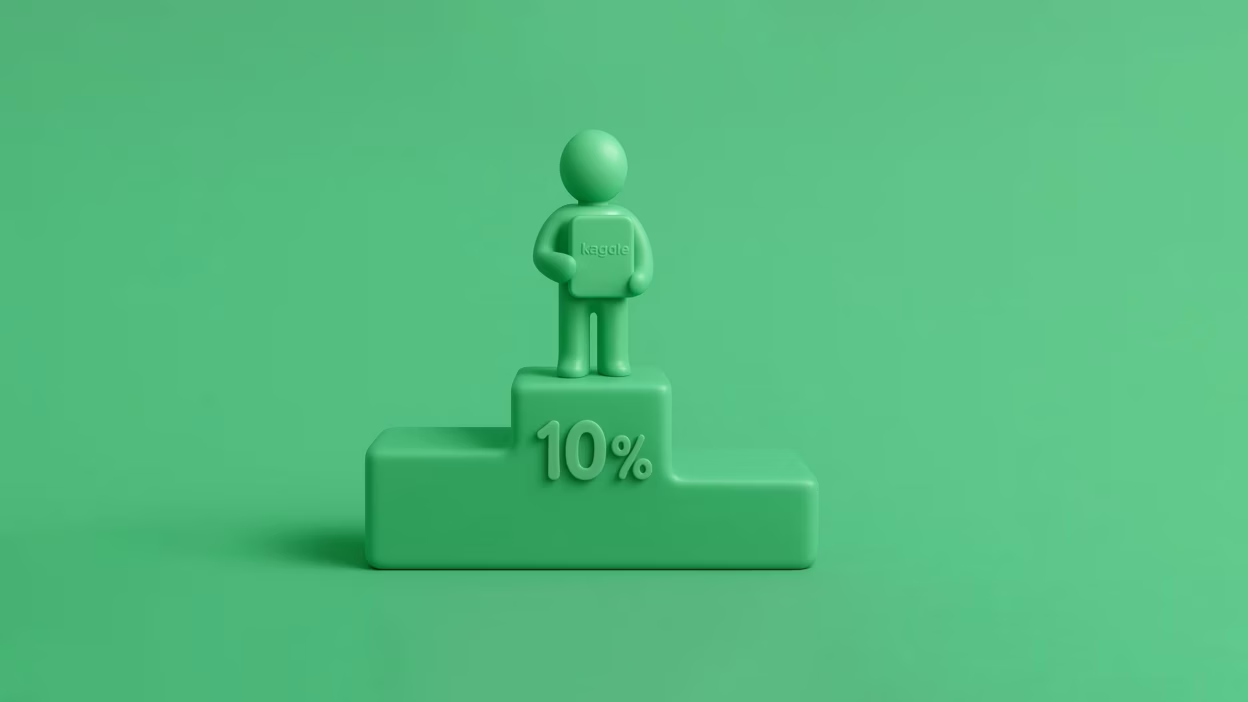It always starts the same way.
You hear about Kaggle. Maybe a mentor mentions it. Maybe it shows up when you Google “how to become a real data scientist.” Maybe you just want to flex that new Python badge you earned.
So you make an account.
You open your first competition.
And then — bam — a tsunami of CSV files, leaderboard scores, and forum threads written in what seems like a secret language.
Where the hell do you even start?
I get it. When I first opened a Kaggle competition, I stared at that dataset like it had personally insulted my family.
But here’s the real talk: You can go from Kaggle Newbie to Top 10%—even Top 5%—way faster than you think.
You don’t need a Ph.D. You don’t need 18 hours a day. You need strategy.
And you need a little stubbornness.
Let’s break it down, step by step.
Step 1: Stop Worshipping the Leaderboard (At First)
Look, leaderboards are sexy. Those shiny top spots, the usernames with 50 gold medals…it’s intoxicating.
But if you start by obsessing over your rank, you’ll quit by Day 3.
Here’s something most newbies don’t realize: Early Kaggle is about learning how to build, not how to win.
The leaderboard can wait. Right now, you’re building the muscle memory: loading data, cleaning messes, feature engineering, modeling, submitting.
Every submission is a workout rep. It’s not a grade.
And just like at the gym, nobody actually cares if you look a little ridiculous when you start.
Quick tip:
Find the Getting Started competitions. Titanic, House Prices, Spaceship Titanic—they’re practically designed for you to mess around without pressure.
Bonus:
The public leaderboard often lies. Like, straight-up gaslights you.
Because the final ranking is usually based on a private test set you don’t see until the competition ends.
So yeah—don’t marry the leaderboard. Flirt with it, maybe. But your real commitment? Improving your notebook, bit by bit.
Step 2: Build One Crappy Model. Fast.
You wanna know a dirty secret?
Your first Kaggle model should suck.
In fact, if it doesn’t suck, you’re probably wasting time overthinking.
The goal of your first model isn’t to score high—it’s to break the “blank screen” curse.
Get something on the board. Anything.
- Load the data.
- Handle missing values quick and dirty (mean imputation? why not).
- Fit a basic logistic regression or decision tree.
- Submit.
Boom. You’re officially a Kaggle competitor.
My first submission story:
It was for Titanic. I literally filled all missing values with zeros, trained a random forest without tuning a single hyperparameter, and submitted it.
Result? 63% accuracy.
It felt like winning an Oscar.
Your first model gets you unstuck. And once you’re unstuck, you can start getting smart.
Step 3: Understand the Problem Like a Nosy Detective
Here’s where most people stumble: they model too early.
Top Kagglers? They obsess over understanding the problem first.
Imagine you’re Sherlock Holmes with a laptop.
- What’s the target variable, really?
- How’s it distributed?
- Are there obvious leaks or hints in the features?
- Which columns smell weird? (You know the ones. 95% null values. Strange formatting. Suspicious outliers.)
Spend at least an hour just looking at the data:
df.describe()df.info()- histograms, boxplots, violin plots
- correlation heatmaps
Be nosy. Be annoying. Poke every corner of that dataset.
Because here’s the truth: You don’t win Kaggle by modeling harder—you win by understanding better.
Step 4: Feature Engineering > Fancy Models
When you’re starting out, it’s tempting to think,
“If I just use XGBoost, I’ll automatically win.”
Nope.
A mediocre model + great features beats a great model + garbage features, almost every time.
This means your real job early on is feature engineering:
- Create ratios (like Fare per Family Member in Titanic)
- Create bins (like Age groups: kid, adult, senior)
- Extract datetime parts (year, month, weekday)
- Encode categorical variables smartly (label encoding, target encoding)
- Count or frequency encode rare categories
Every new feature is a new lens through which your model can see the world a little better.
When I first cracked the Top 10%?
It wasn’t because I tuned hyperparameters for 10 hours.
It was because I created two new features nobody else bothered with.
Small hinges swing big doors.
Step 5: Learn the “1-Model, 2-Model, 3-Model, Blend!” Rhythm
Eventually, you’ll hit a ceiling with a single model.
This is where ensembling sneaks in.
You don’t have to get crazy. You don’t need stacking towers 10 layers deep like some Kaggle veterans.
Early on, just master this simple rhythm:
- Train a few different models (Random Forest, XGBoost, LightGBM, CatBoost, maybe even Logistic Regression for laughs).
- Take their predictions.
- Average them.
That’s it.
This simple blending—called “soft voting”—can bump your score by 1–2%. Sometimes even more.
It’s stupidly powerful for how little effort it takes.
Later, you can learn about:
- Model stacking
- Pseudo-labeling
- Bagging and boosting blends
But for now? Blend and smile.
Step 6: Read the Damn Forums
You want a cheat code to learning Kaggle faster?
The discussion forums are absolute gold.
Especially:
- EDA (Exploratory Data Analysis) threads
- Top solution summaries
- “What I learned” posts from other newbies
Here’s how you work it:
- Read one top post every night like a bedtime story.
- Bookmark smart ideas (like clever feature engineering tricks).
- Try copying one technique you learn, even if you don’t fully get it yet.
The Kaggle forums taught me about feature interaction, target leakage, adversarial validation—all stuff that would’ve taken me years to figure out alone.
You’re not cheating.
You’re learning from the best.
Step 7: Fail Early, Fail Publicly, Fail Proudly
Kaggle’s greatest gift isn’t the shiny medals.
It’s the chance to fail in public without real consequences.
- Submit garbage models.
- Share messy notebooks.
- Ask dumb questions.
- Get negative feedback sometimes.
You won’t get fired. Nobody’s sending your mom an email.
Every “failure” here is actually a flex.
It means you’re showing up.
You’ll watch your old notebooks a year from now and cringe so hard you pull a muscle.
But you’ll also see your progress like a time-lapse video.
That’s rare. And that’s priceless.
The Tactical Timeline: How Fast Can You Actually Climb?
Here’s a rough timeline if you stick to it:
- Week 1: Make an account. Submit to Titanic. Build a trash model. Celebrate.
- Weeks 2–3: Grind one “Getting Started” competition. Obsess over EDA. Learn basic feature engineering.
- Weeks 4–6: Try your first blend. Maybe hit Top 50% by accident. Feel smug.
- Months 2–4: Start competing seriously. Join team-ups in late-stage comps. Read solution writeups.
- Months 5–8: If you stay consistent? Cracking Top 10% is totally realistic.
Some people even medal in under a year.
The biggest difference-maker?
Consistency beats intensity.
15 minutes a day > 3 hours once a month.
Final Pep Talk: Why You’re Closer Than You Think
You don’t have to be a genius.
You don’t have to know deep learning inside-out.
You don’t have to sacrifice your social life on the altar of Kaggle.
You just need to:
- Show up even when your leaderboard score drops.
- Keep making tiny, ugly improvements.
- Read, copy, and remix other people’s brilliance without shame.
- Treat every competition like a puzzle, not a competition.
And most importantly?
Don’t quit 3 feet from gold.
Somewhere out there, your future self is posting their first silver medal announcement.
And they’re laughing because they remember the day you almost gave up.
Spoiler: they’re really proud of you.





